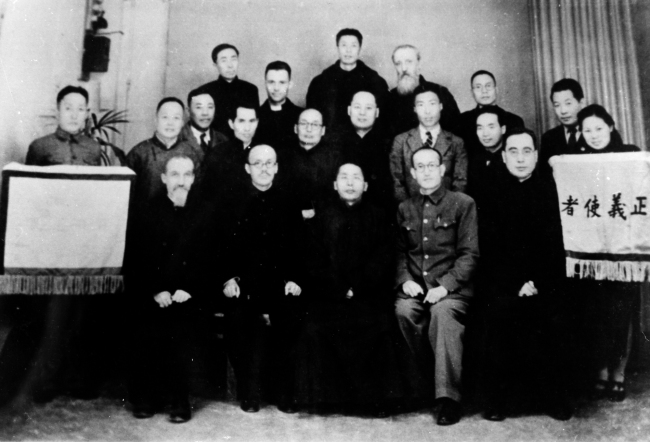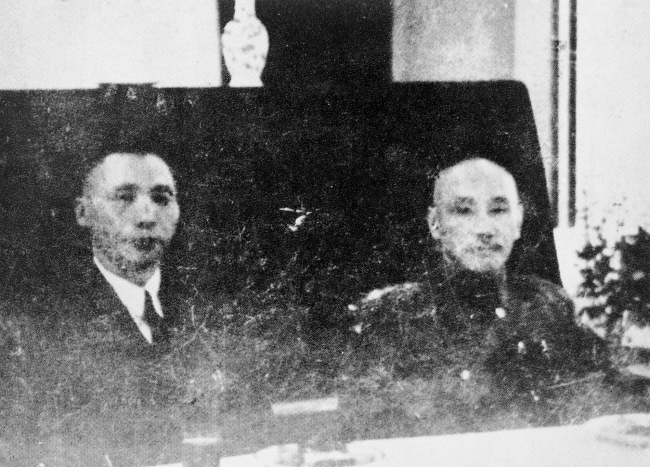[Foreigners Who Loved Korea 12] Chen Guofu, the bridge of the Korean Independence Movement
By KH디지털2Published : Feb. 22, 2016 - 14:30
In Korea’s turbulent path toward independence and nation building, there were foreign nationals who stood steadfastly by the Korean people, although their contributions have been largely overshadowed by those of Korean patriots. The Korea Herald, in partnership with the Independence Hall of Korea, is publishing a series of articles shedding light on these foreigners, their life and legacies here. This is the eighth installment. ― Ed.
During Japanese colonial rule, China was the most important stage of action for Korean independence activists. The independence movement in China, began before the founding of the Provisional Government of the Republic of Korea and lasted for close to 40 years. In the process, many Chinese spared no effort to spiritually or materially support the Korean independence movement. Among them, three members of a single family and their ties to the Korean independence activists stand out: Chen Guofu, his uncle Chen Qimei, and his younger brother Chen Lifu, who were awarded the Order of Merit for National Foundation, Republic of Korea Medal, and Order of Merit for National Foundation, respectively.
Ties between Korea and Chen Guofu
Chen Guofu, born on Oct. 27, 1892, to a prestigious family in Wuxing, Zhejiang Province, was originally named Zu Tao. After attending Mingde School in Changsha in 1905, he entered a primary infantry school in Hangzhou when it was established in the summer of 1907 and studied there for four years. Due to the influence of his uncle Chen Qimei, he formally registered in the revolutionary organization, the Tongmenghui, in 1910.
Chen graduated from the primary infantry school in April 1911 and entered Nanjing’s fourth middle infantry school in June the same year. When the Xinhai Revolution erupted, Chen and his fellow students headed to Wuhan to take part in the fighting, but were forced instead to go to Shanghai where Chen Qimei resided. It was here that he first met Chen Qimei’s sworn brother, Chiang Kai-shek. This was around the time when Chen Guofu began to establish ties with Korean independence activists.
During Japanese colonial rule, China was the most important stage of action for Korean independence activists. The independence movement in China, began before the founding of the Provisional Government of the Republic of Korea and lasted for close to 40 years. In the process, many Chinese spared no effort to spiritually or materially support the Korean independence movement. Among them, three members of a single family and their ties to the Korean independence activists stand out: Chen Guofu, his uncle Chen Qimei, and his younger brother Chen Lifu, who were awarded the Order of Merit for National Foundation, Republic of Korea Medal, and Order of Merit for National Foundation, respectively.
Ties between Korea and Chen Guofu
Chen Guofu, born on Oct. 27, 1892, to a prestigious family in Wuxing, Zhejiang Province, was originally named Zu Tao. After attending Mingde School in Changsha in 1905, he entered a primary infantry school in Hangzhou when it was established in the summer of 1907 and studied there for four years. Due to the influence of his uncle Chen Qimei, he formally registered in the revolutionary organization, the Tongmenghui, in 1910.
Chen graduated from the primary infantry school in April 1911 and entered Nanjing’s fourth middle infantry school in June the same year. When the Xinhai Revolution erupted, Chen and his fellow students headed to Wuhan to take part in the fighting, but were forced instead to go to Shanghai where Chen Qimei resided. It was here that he first met Chen Qimei’s sworn brother, Chiang Kai-shek. This was around the time when Chen Guofu began to establish ties with Korean independence activists.

Yuan Shikai, seeking to isolate Chen Qimei from the national political stage in late 1912, proposed an overseas inspection and provided him with an enormous sum of 40,000 yuan under the pretext of traveling costs. The money, which was managed by Chen Guofu upon Chen Qimei’s command, was exhausted within just two months. Of that sum, 8,000 yuan was sent as funding for the activities of Korean independence activists in Shanghai and tuition for Korean students studying abroad. Chen not only delivered funds, he registered with the New Asia Society and plunged himself into supporting the Korean independence movement.
Sin Kyu-sik was a person he contacted frequently at the time. In 1913, Jo So-ang -- who was on good terms with Tai Chi-tao, Chiang Kai-shek’s close friend, during his study abroad in Japan -- fled to Shanghai. Chen allied with Sin Kyu-sik, Jo So-ang and others, forming the Grand Alliance Party and initiating a united struggle against the Japanese.
Proving his potential
Chen, who had returned home following Chen Qimei’s murder in May 1916, plunged into Shanghai’s financial industry in 1918. In 1920, when Sun Yat-sen established a stock exchange in Shanghai to fund the revolution, Chen acted as a stock broker at Chiang Kai-shek’s request. Raking in significant profits at the time, all of the money was used to fund the revolution or extricate the families of deceased patriots. Chen contributed some funds to Korean independence activists and gave them donations for the Inseong School.
In January 1924, Chiang Kai-shek, the appointed Commandant of the Whampoa Military Academy, went down south and requested Chen’s aid, but was met with refusal. Instead, Chen stayed in Shanghai and furnished the military equipment needed by its military academy and the entirety of its supplies. Moreover, he took on the task of recruiting applicants for the military academies in Huazhong and Huabei and sending them to Guangzhou. Although executing his duties in an area controlled by the Beiyang Army carried great risk, Chen recruited more than 3,000 men. Among them were many Korean youths recommended by the Provisional Government of the Republic of Korea.

In January 1926, Chen was elected as a member of the Central Audit Committee at the Kuomintang’s Second National Convention in Guangzhou. At this time, Chen substituted his name with “Guofu,” to make it easier to recruit applicants in secret for the military academy in Shanghai. In May 1926, Chen formally began his activities in party affairs when Chiang Kai-shek, appointed head of the Organization Department, dispatched him as the department’s Secretary. In July 1926, Chen stood in for Chiang when he had to leave his post to lead as commander-in-chief of the Northern Expedition Army, and was formally appointed in his place on July 13, a post which he resigned from on Feb. 15, 1927.
Chiang, who had resigned in August 1927, was later restored in January the following year as commander-in-chief of the Northern Expedition Army and head of the Organization Department. In order to continue the Northern Expedition through February, Chiang had Chen take his place as head of the department. On Oct. 16, 1928, the Government of the Republic of China made official its five branches of organization, and Chen was appointed vice director of the Control Branch. In the third National Convention of the Nationalist Party held in March 1929, Chen was elected director of the Central Executive Committee and appointed vice director of the Organization Department. He took on Chiang’s duties as deputy. When Chen resigned on June 14, 1931, his younger brother Chen Lifu succeeded Chiang’s seat as director.
Connecting Kim Gu and Chiang
Despite being busy with government and party duties, Chen’s interest and support of the Korean independence movement continued and his words were a target of surveillance by Japanese secret agents. One noteworthy incident involved the telegram that the Shanghai Japanese Consulate had sent to the Ministry of Foreign Affairs in the aftermath of Yi Bong-chang’s assassination attempt against Japanese Emperor Hirohito. The telegram claimed that Chen was the primary agent of this incident and had conspired to give money to Yi through Kim Gu to execute the affair.
When Yun Bong-gil was executed on April 29, 1932, Kim Gu, who had a bounty of 600,000 yuan on his head, fled to Jiaxing. Although it is widely known that he had received Zhu Fucheng’s aid in the process, Chen had in fact asked Zhu to protect Kim. Chen, restricted from coming forward, requested that Zhu arrange for Kim’s escape. Zhu was then president of Shanghai Law School and also hailed from Chen’s hometown.

Chen’s support for the Korean independence movement was actualized as his position in the Kuomintang became stable, however his official duties kept him from directly coming to the fore. Support for the Korean independence movement was carried out for quite a while by Xiao Zheng and Gong Peicheng, who both appear in Kim Gu’s memoir, “Paekbeom Ilji.” Both figures had close relationships with Chen as a result of Xiao’s career in the Central Organization Department and Gong’s experience as an instructor in the Central School of Governance while Chen was its superintendent. Hence Chen showed support for the Korean independence movement through his relationships with them instead.
On July 15, 1932, Chiang sent a telegram to Teng Jie, executive director and secretary of the Blue Shirts Society, ordering him to quickly dispatch three people to Gong Feicheng.
This was accomplished through Chen upon Kim Gu’s request, but the above-mentioned three individuals later took orders from Kim Gu and carried out missions in the Northeast. In addition, Gong Feicheng, who met Kim Gu in Jiaxing, conveyed a request for the supply of 1,000 rifles to Chiang. This suggestion was submitted after consulting with Chen.
One of the great successes of Chen’s role as a bridge for the Korean independence movement was arranging an audience with Chiang for Kim Gu.
In the meeting at Chiang’s official residence in the Nanjing Infantry Military Academy, Kim Gu requested material support for the independence movement. The next day, Chen invited Kim separately to his villa, spoke in Chiang’s stead and discussed the problems of admitting Korean youths into Chinese military academies. Thus in February 1934, 100 Korean youths were able to undergo military training in a special Korean class established in the Luoyang Military Academy in Henan province.
Holding onto ties of revolution
Chen Guofu was appointed governor of Jiangsu Province on Oct. 12, 1933 and he served there until Nov. 11, 1937. At the time, with Zhenjiang as the capital of the province, Chen traveled back and forth between Nanjing and Zhenjiang and maintained communications with members of the Provisional Government of the Republic of Korea there. Chen, who was appointed superintendent of the Central School of Governance in mid-January 1938, moved with the school and arrived in Chongqing on July 6.
Chen was appointed head of the third military aide-de-camp office and chair of the military committee, once again attending to Chiang’s person. Although he was appointed as head of the KMT’s Central Organization Department on May 26, 1944, he resigned due to health reasons on Nov. 20, 1944. On July 17, 1944, Chen invited the president of the Provisional Government of the Republic of Korea Kim Gu, vice president Kim Kyu-sik, and other cabinet members to a banquet in celebration of the victory close at hand of China’s struggle against Japan and Korean independence.
Chen poured his energy into developing Chinese traditional medicine after resigning as head of the Organization Department. He went to Taiwan on Dec. 6, 1948 to recover his health and died in Taipei on Aug. 25, 1951. He had leapt onto the path of revolution from a young age and dedicated his life to the fatherland, sparing no effort to support Korean independence for decades. In recognition of his service, the Korean government posthumously awarded him the Order of Merit for National Foundation, Republic of Korea Medal in 1966.
By Kim Young-sin
Research Professor at Wonkwang University









![[Graphic News] How much do Korean adults read?](http://res.heraldm.com/phpwas/restmb_idxmake.php?idx=644&simg=/content/image/2024/05/16/20240516050803_0.gif&u=)







![[Herald Interview] Byun Yo-han's 'unlikable' character is result of calculated acting](http://res.heraldm.com/phpwas/restmb_idxmake.php?idx=652&simg=/content/image/2024/05/16/20240516050855_0.jpg&u=)
